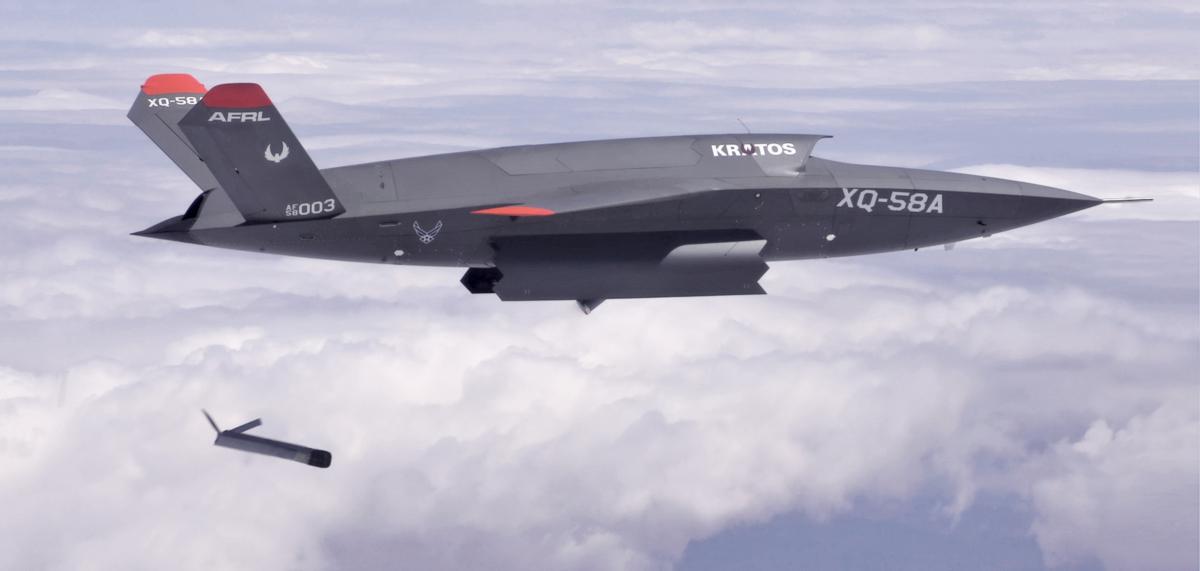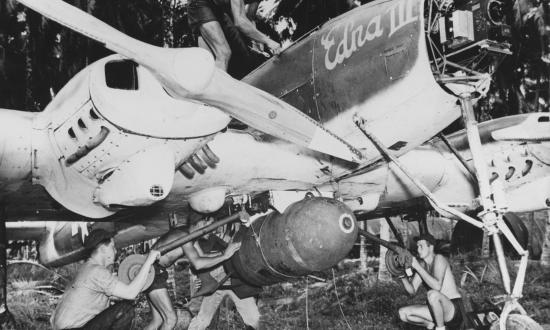A generation of fighter pilots grew up on the 1980s swing-wing F-14 Tomcats, bomber jackets, and aviator sunglasses captured in the film Top Gun. They discovered their calling while watching Tom Cruise tear through the skies. Thirty-five years after Top Gun’s debut, however, naval aviation looks vastly different.
One development in particular is altering the landscape: unmanned aerial systems (UASs). Today, the Navy makes regular use of unmanned platforms to achieve tactical and operational objectives. The MQ-4C Triton complements the P-8 Poseidon’s primary mission of intelligence, surveillance, and reconnaissance (ISR) and shortens the detect-to-engage sequence. Providing surveillance at a range of up to 2,000 nautical miles, the Triton enhances situational awareness for fleet commanders.The MQ-8 Fire Scout also provides ISR to the fleet and can locate, track, and designate targets while providing accurate targeting and battle damage information.1
While UASs show incredible promise in ISR and aerial refueling, the vision for unmanned in strike warfare is undetermined. Moving forward, however, it is imperative that manned platforms retain responsibility for the strike itself, with unmanned systems in supporting roles alongside. This combination of manned and unmanned platforms will leverage UAS capabilities and ensure strike warfare remains relevant in increasingly complex operational environments.
Living in the Present . . .
Strike warfare is overlooking the potential of unmanned platforms. Northrop Grumman’s once promising X-47B has been shelved. The Joint Unmanned Combat Air System, originally designed to provide a stealthy unmanned strike platform, has been aborted by the Air Force, and its role in naval aviation has been downgraded from strike to primarily ISR with some strike capabilities and aerial refueling.2 Even the Navy’s MQ-25 currently is planned as primarily a tanker aircraft with some ISR capabilities—not a strike asset.3
This limited role is incredibly short-sighted. A study by the Center for Strategic and Budgetary Assessments noted that the ranges of strike aircraft have been cut to increase maneuverability and speed. Prospective UASs would not be subject to the same constraints and could increase the effective range of the carrier strike group (CSG).4 In addition, mission planners likely would be more willing to expend a cheaper unmanned asset than a manned one. The Gerald R. Ford–class carriers, equipped with electromagnetic launch systems, could easily adapt to the smaller, lighter platforms, and unmanned aerial vehicles’ (UAVs’) significantly smaller fuselage would allow more platforms to embark with the carriers, giving commanders more assets to employ.
Unmanned systems do have drawbacks. Payloads of unmanned strike platforms under development are underwhelmingly small.5 Inclement weather can inhibit sensors and the recovery of assets on a carrier. Remotely operated unmanned systems also are vulnerable to offensive electronic warfare, which can interrupt the link between operator and platform.6 Without a pilot present to troubleshoot, these multimillion-dollar weapon systems risk becoming harmless remote-controlled planes if compromised.
Nevertheless, unmanned platforms could bridge gaps between U.S. and near-peer capabilities. Some minor adjustments in vision could lead to development and implementation of a manned–unmanned strike team that is more lethal than ever.
. . . Planning for the Future
Through the carrier strike group, strike warfare offers the ability to project power anywhere when needed. Standing in the way is the adversary’s ever-increasing arsenal of antisurface and surface-to-air missile (SAM) systems, electronic jamming assets, and air-to-air capabilities—all designed specifically to make the CSG operationally obsolete, a loss the joint forces cannot endure but one UASs can help avoid.
On their own, UASs have the potential to excel in several areas. Drones equipped with electronic jamming could work in coordination with traditional strike platforms, taking on dangerous missions such as stand-in jamming. If stand-in jamming is unachievable, UAVs could contribute to stand-off jamming. One of the hardest parts of stand-off jamming for aircrews is path planning to cover multiple radar sites and maximize jamming effectiveness.7 Because of their smaller size, UAVs could embark and launch from carriers in greater numbers, increasing jamming coverage and minimizing the difficulties of individual path planning.
Unmanned systems also have proven their ability to provide reliable ISR and target acquisition. UAVs pressing into contested airspace could use those capabilities to allow traditional strike platforms to release their ordnance from a safe distance. This would improve the range at which the CSG could project power and counter enemy antiaccess/area denial (A2/AD) measures.
Independently, UASs can contribute significantly to the strike mission, but employing them in conjunction with manned platforms would maximize their utility and free aircrews to focus on employing their weapon systems more effectively. With no strike capabilities on the UAV itself, ethical decisions regarding life and death are left to the human in the cockpit. However, arming drones with self-defense capabilities is a necessary precaution. Equipped with basic defenses such as chaff, flares, or towed decoy systems, the UAV would add a layer of protection for both itself and the pilot on station. Taken a step further, arming UAVs with air-to-air capabilities would redefine air superiority. Smaller radar cross-sections and superior maneuverability coupled with instantaneous processing speed could make autonomous systems more lethal than humans in air-to-air combat.8
The vision for unmanned platforms in strike warfare needs to be as guardian angels—protecting manned assets and enabling them to focus on engaging their weapon systems. This vision is taking shape at Boeing. Its Loyal Wingman project seeks to design an unmanned platform able to fly sorties alongside aircrews and alleviate some of their collateral responsibilities. Recent tests have been successful, and Australia already has ordered six unmanned sidekicks.9 The Air Force has taken notice, and last December, it awarded Boeing and others contracts to produce a “low-cost, artificially intelligent, autonomous drone that can perform missions in contested environments alongside fighter aircraft.”10
U.S. partners and allies are not the only ones investing in unmanned strike capabilities. Russia has developed and begun testing the Okhotnik, a stealthy drone with a 13,000-pound munitions payload.11 China also has invested heavily in unmanned strike and has a slew of UASs operating in the South China Sea, where naval aviation and strike warfare are at a crossroads.12
The South China Sea
In recent years, China has established one of the densest networks of overlapping radar and missile defenses in the world. This, plus its continued construction of military bases on artificial islands in the South China Sea, presents a unique challenge for the United States—the region has turned into an incredibly dangerous A2/AD environment.
As it seeks to increase the stand-off range of enemy forces at sea, China has acquired the Russian S-400 SAM in addition to its own domestically produced HQ-9.13 The S-400 boasts a range of up to 400 km.14 On the antisurface side, China’s primary medium-range antiship ballistic missile—the DF-21, dubbed a “carrier killer”—is effective beyond 1,500 km.15 Continued progress in China’s missile capabilities will further increase the stand-off range for a CSG, threatening to neutralize naval aviation’s ability to project power. These obstacles to strike capabilities are best overcome by a combination of UASs and manned platforms.
Specifically, UASs would be key to softening China’s SAM and antiship missile grid through electronic warfare. The sheer number and overlap of China’s radar and missile sites increases the need for carrier aviation platforms dramatically—more target sites require more strike aircraft, which in turn require more jamming assets for protection. Rather than spreading a single squadron of five Growlers thin, UASs could supplement these aircrews and increase coverage against each Chinese jamming site.16 In both effectiveness and deck space, UASs could efficiently supplement electronic warfare capabilities in carrier-based strike operations.
UASs also could assume the target acquisition role. With unmanned vehicles flying closer to shore to stake out Chinese radar and missile sites, Super Hornets or F-35s acting as “missile trucks” could launch munitions from a greater distance.17 In addition, armed with defensive capabilities, UAVs could act as escorts. Strike aircraft could enter a mission fully loaded without fear of losing maneuverability and focus solely on delivering ordnance.
Naval aviation’s need for UASs extends beyond the South China Sea, but the A2/AD environment China has created showcases the importance of integrating these platforms into strike warfare going forward.
Conclusion
Traditionally, the vision for UASs in strike warfare has been as a deep-strike capability, but while this capability is under development, UASs can adapt their role to ensure the CSG’s ability to project power. Using UASs to supplement manned aircraft in escort, jamming, and target acquisition roles is an imperative addition to the strike mission set.
With Top Gun 2 in a holding pattern, the next generation of naval aviators can rest easy knowing their dreams of buzzing the tower will not be dashed by UASs. Unmanned systems may be on their way into strike warfare, but pilots are certainly not on the way out.
1. Naval Aviation Vision: 2016–2025 (Washington, DC: NAE Publication Distribution, 2016), 28.
2. David Hambling, “Russia Seeks Lead over U.S. with Accelerated Stealth Drone Program,” Forbes, 7 August 2020.
3. Sam LaGrone, “Navy Has No Plans to Develop Lethal Carrier UAV before MQ-25A Hits Flight Decks,” USNI News, 22 May 2019.
4. Sam LaGrone, “Report: U.S. Carriers Need New Lethal Unmanned Aircraft, New Fighter to Stay Relevant,” USNI News, 5 March 2019.
5. Hambling, “Russia Seeks Lead Over U.S.”
6. LCDR Allan Elsberry, USN, personal communication, 3 March 2021.
7. Elsberry, personal communication.
8. Oriana Pawlyk, “Rise of the Machines: AI Algorithm Beats F-16 Pilot in Dogfight,” Military.com, 24 August 2020.
9. Valerie Insinna, “Australia Makes Another Order for Boeing’s Loyal Wingman Drones after a Successful First Flight,” Defense News, 3 March 2021.
10. Insinna, “Australia Makes Another Order for Boeing’s Loyal Wingman Drones.”
11. Hambling, “Russia Seeks Lead over U.S.”
12. Rick Joe, “China’s Growing High-end Military Drone Force,” The Diplomat, 27 November 2019.
13. “China’s Anti-Access Area Denial,” Missile Defense Advocacy Alliance, 24 August 2018.
14. MAJ John Wagemann Jr., USAF, Chinese Grand Strategy: How Anti-Access/Area Denial (A2AD) Fits in China’s Plan (Maxwell Air Force Base, AL: Air Command and Staff College, April 2014).
15. Joseph Trevithick, “Chinese Long-Range Ballistic Missile Struck Moving Ship in South China Sea: Report,” The War Zone, 16 November 2020.
16. Elsberry, personal communication.
17. Jerry Hendrix, “Retreat from Range: The Rise and Fall of Carrier Aviation,” Center for a New American Security, October 2015.






